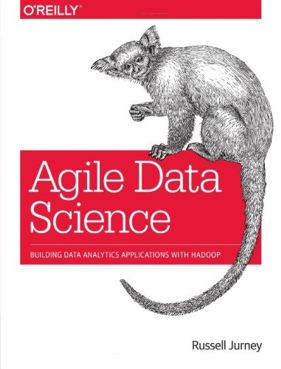| Agile Data Science |
| Written by Kay Ewbank | |||
|
Author: Russell Jurney
This short book looks at creating an application using the technologies that fit around Hadoop. It was written with the aim of ensuring developers working with Hadoop create successful applications. The author, Russell Jurney,says the book combines three goals: to provide a how-to guide for building analytic applications with Hadoop; to help teams collaborate on big projects in an agile manner; and to give structure to the practice of applying agile big data analytics. The book is written from a Linux and UNIX perspective. There are no examples for Windows users, but there are extensive examples for Linux. Code and supporting materials is available on GitHub. The book is split into two parts. The first part introduces the data and toolset that is used in the tutorials in the second part, which consists of a set of tutorials to put together an analytical application.
Part I opens with a short chapter introducing the agile big data methodology. A second short chapter then introduces the data set used in the book (a collection of emails), and shows how to make a simple prediction based on probability. The toolset used by the author consists of Avro, Python, Pig, MongoDB, ElasticSearch and Wonderdog, and these are introduced in the next chapter. This is possibly the most useful chapter in the book; a nice clear introduction to each of the tools in turn, why you need it, what it does, and how it fits with the other tools. The final chapter in Part I looks at how to scale the tools from the previous chapter ‘to petabyte scale’ using the cloud in the form of dotCloud, Amazon Web Services, and Google Analytics.
Part II takes the form of tutorials to put together an application. The section starts with a chapter showing how to collect and display records through a web app on ElasticSearch. Next Jurney shows how to create and display charts of the data. There’s a good chapter on extracting entities from the data and linking them to create interactive reports. The next chapter looks at making predictions – in this case predicting response rates to emails. The material here was good, but brief. It showed how to use statistical methods and analytics that you already know, but you couldn’t learn the topic from what’s covered here. The book ends with a chapter showing how to extend your predictions app into a real-time classifier using native Bayes. Overall, I enjoyed reading this book. The material is well written and very comprehensible. There are extensive code samples, so the actual text is actually quite short. The ‘agile’ part of the title is a bit misleading; the subtitle – building data analytics applications with Hadoop – is much more accurate. However, this isn’t a book that teaches you about Hadoop. What it does do (and does well) is to take the components around Hadoop – Pig, MapReduce and Avro serialization – and show how they fit together and how to use them, alongside MongoDB and ElasticSearch. In summary, the book has some drawbacks, but it’s a good introduction to putting together an application with Hadoop.
|
|||
| Last Updated ( Monday, 26 January 2015 ) |

